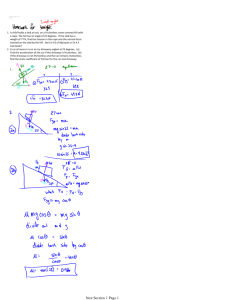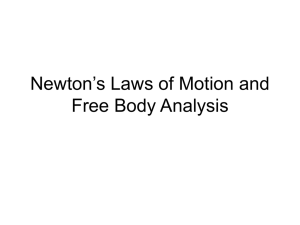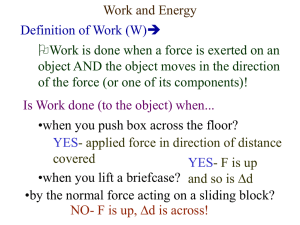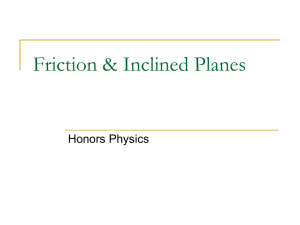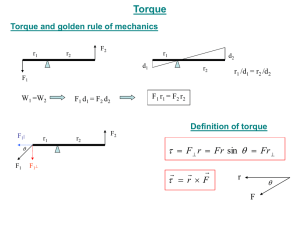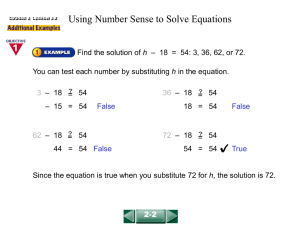2D Dynamics Worksheet: Forces, Acceleration, Friction
advertisement
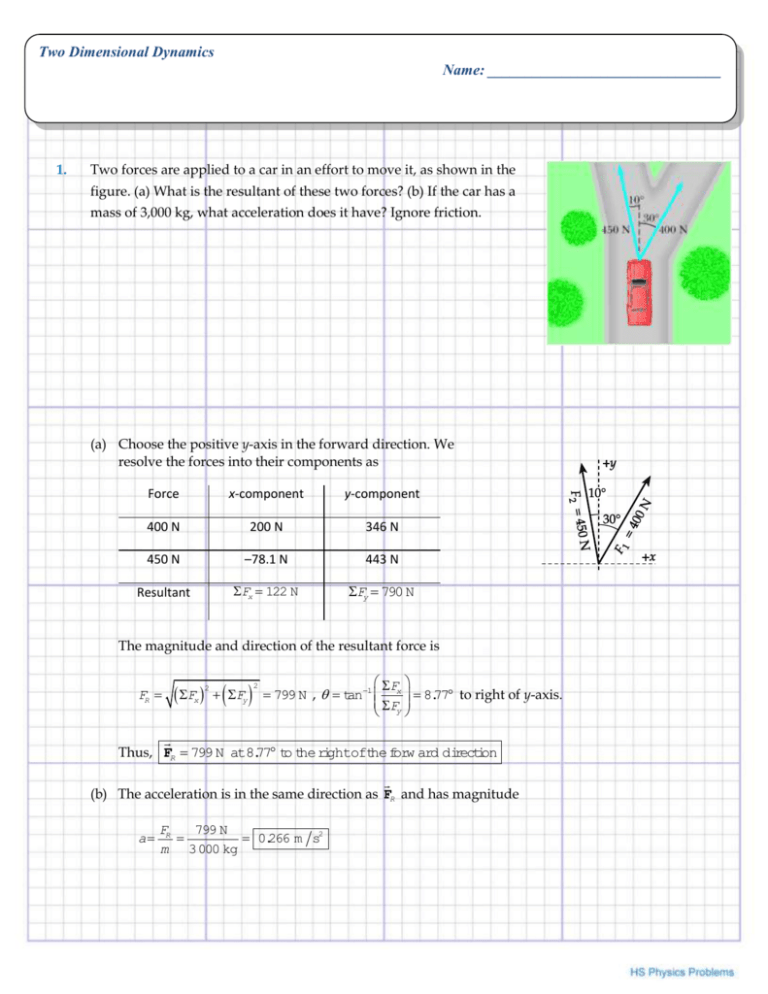
Two Dimensional Dynamics Name: _______________________________ 1. Two forces are applied to a car in an effort to move it, as shown in the figure. (a) What is the resultant of these two forces? (b) If the car has a mass of 3,000 kg, what acceleration does it have? Ignore friction. (a) Choose the positive y-axis in the forward direction. We resolve the forces into their components as Force x-component y-component 400 N 200 N 346 N 450 N –78.1 N 443 N Resultant Fx 122 N Fy 790 N The magnitude and direction of the resultant force is FR Fx 2 Fy 2 F 799 N , tan1 x 8.77 to right of y-axis. Fy Thus, FR 799 N at8.77 to the rightofthe forw ard direction (b) The acceleration is in the same direction as FR and has magnitude a FR 799 N 0.266 m s2 m 3000 kg 2. The force exerted by the wind on the sails of a sailboat is 390 N to the north. The water exerts a force of 180 N east. If the boat (including its crew) has a mass of 270 kg, what are the magnitude and direction of its acceleration? Since the two forces are perpendicular to each other, their resultant is: FR Thus, a 180 N 2 390 N 2 430 N , at FR 430 N 1.59 m s2 m 270 kg or tan 1 390 N 65.2 N ofE 180 N a 1.59 m s2 at65.2 N ofE 3. A 150-N bird feeder is supported by three cables as shown in the figure. Find the tension in each cable. (36.1 m/s at 60.1° below the horizontal) From Fx 0 , T1 cos30.0 T2 cos60.0 0 or T2 1.73 T1 (1) Then Fy 0 becomes T1 sin30.0 1.73 T1 sin60.0 150 N 0 which gives T1 75.0 N in the rightside cable Finally, Equation (1) above gives T2 130 N in the leftside cable 4. Two people are pulling a boat through the water as in the figure. Each exerts a force of 600 N directed at a 30.0° angle relative to the forward motion of the boat. If the boat moves with constant velocity, find the resistive force exerted by the water on the boat. The resultant force exerted on the boat by the people is 2 600 N cos30.0 1.04 103 N in the forward direction. If the boat moves with constant velocity, the total force acting on it must be zero. Hence, the resistive force exerted on the boat by the water must be f 1.04 103 N in the rearw ard direction 5. Two packing crates of masses 10.0 kg and 5.00 kg are connected by a light string that passes over a frictionless pulley as in the figure. The 5.00-kg crate lies on a smooth incline of angle 40.0°. Find the acceleration of the 5.00kg crate and the tension in the string. Let m 1 10.0 kg , m 2 5.00 kg , and 40.0 . Applying the second law to each object gives and m 1a m 1g T (1) m 2a T m 2 g sin (2) Adding these equations yields m m 2 sin a 1 g , or m 1 m 2 10.0 kg 5.00 kg sin 40.0 a 9.80 m s2 4.43 m s2 15.0 kg Then, Equation (1) yields T m 1 g a 10.0 kg 9.80 4.43 m s2 53.7 N 6. A 40.0-kg wagon is towed up a hill inclined at 18.5° with respect to the horizontal. The tow rope is parallel to the incline and has a tension of 140 N. Assume that the wagon starts from rest at the bottom of the hill, and neglect friction. How fast is the wagon going after moving 80.0 m up the hill? Choose the positive x axis to be up the incline. Then, Fx m ax T (m g)sin18.5 m ax which gives ax T 140 N g sin18.5 9.80 m s2 sin18.5 0.390 m s2 m 40.0 kg The velocity after moving 80.0 m up the incline is given by v= v02 2ax x = 0+2 0.390 m s2 80.0 m 7.90 m s 7. A 1 000-N crate is being pushed across a level floor at a constant speed by a force F of 300 N at an angle of 20.0° below the horizontal, as shown in the figure. (a) What is the coefficient of kinetic friction between the crate and the floor? (b) If the 300-N force is instead pulling the block at an angle of 20.0° above the horizontal, as shown in Figure P4.37b, what will be the acceleration of the crate? Assume that the coefficient of friction is the same as that found in (a). (a) Since the crate has constant velocity, ax ay 0. Applying Newton’s second law: Fx F cos20.0 fk m ax 0 , or fk 300 N cos20.0 282 N and Fy n F sin20.0 w 0 , or n 300 N sin20.0 1000 N 1.10 103 N The coefficient of friction is then k fk 282 N 0.256 n 1.10 103 N (b) In this case, Fy n F sin20.0 w 0 so n w F sin 20.0 897 N The friction force now becomes fk kn 0.256 897 N 230 N w Therefore, Fx F cos20.0 fk m ax ax and the acceleration is g F cos20.0 f g 300 N cos20.0 230 N 9.80 m a k w 1000 N s2 0.509 m s2 8. The coefficient of static friction between the 3.00-kg crate and the 35.0° incline of the figure is 0.300. What minimum force F must be applied to the crate perpendicular to the incline to prevent the crate from sliding down the incline? The normal force acting on the crate is given by n F m g cos . The net force tending to move the crate down the incline is m gsin fs, where fs is the force of static friction between the crate and the incline. If the crate is in equilibrium, then m gsin fs 0, so that fs Fg sin But, we also know fs sn s F m g cos Therefore, we may write m g sin s F m g cos , or sin sin 35.0 F cos m g cos35.0 3.00 kg 9.80 m s2 32.1 N 0.300 s 9. Find the acceleration reached by each of the two objects shown in the figure if the coefficient of kinetic friction between the 7.00-kg object and the plane is 0.250. First, taking downward as positive, apply the second law to the 12.0 kg block: Fy 118 N T 12.0 kg a (1) For the 7.00 kg block, we have n 68.6 N cos37.0 54.8 N , and f kn 0.250 54.8 N 13.7 N Taking up the incline as the positive direction and applying the second law to the 7.00 kg block gives Fx T f 68.6 N sin 37.0 7.00 kg a, or T 13.7 N 41.3 N 7.00 kg a (2) Solving Equations (1) and (2) simultaneously yields a 3.30 m s2 . 10. A 4.00-kg block is pushed along the ceiling with a constant applied force of 85.0 N that acts at an angle of 55.0° with the horizontal, as in the figure. The block accelerates to the right at 6.00 m/s2. Determine the coefficient of kinetic friction between block and ceiling. Consider the vertical forces acting on the block: Fy 85.0 N sin55.0 39.2 N n m ay 0 , so the normal force is n 30.4 N Now, consider the horizontal forces: Fx 85.0 N cos55.0 fk m ax 4.00 kg 6.00 m s2 or fk 85.0 N cos55.0 24.0 N 24.8 N The coefficient of kinetic friction is then k fk 24.8 N 0.814 n 30.4 N 11. A 3.0-kg object hangs at one end of a rope that is attached to a support on a railroad car. When the car accelerates to the right, the rope makes an angle of 4.0° with the vertical, as shown in the figure. Find the acceleration of the car. In the vertical direction, we have Fy T cos4.0 m g 0, or T mg cos4.0 In the horizontal direction, the second law becomes: Fx T sin 4.0 m a, so a T sin 4.0 g tan 4.0 0.69 m s2 m
